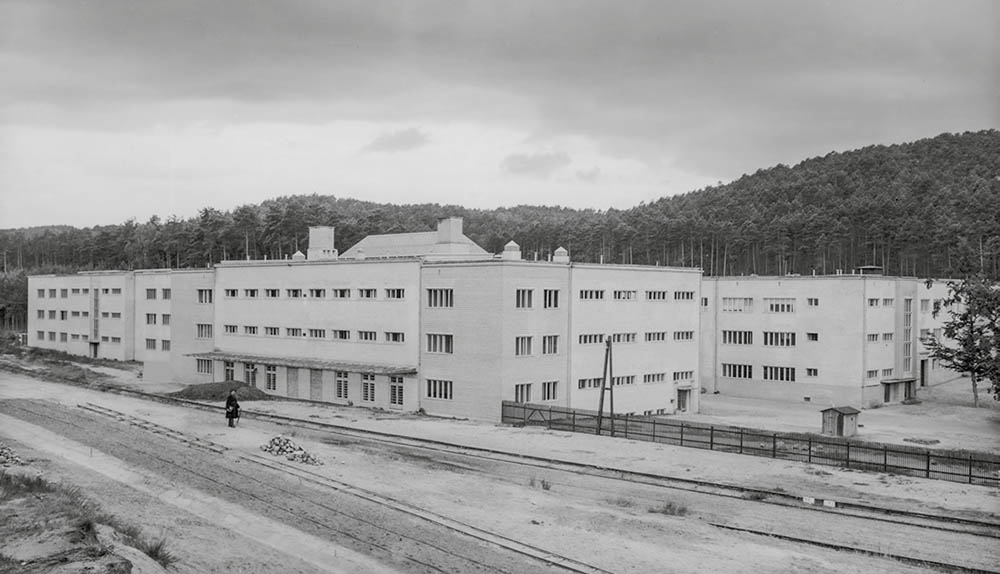A 1928 Modern Passenger Terminal with Top-Tier Hygiene Standards
Downloads
DOI:
https://doi.org/10.52200/docomomo.73.09Keywords:
Architecture history, hotel-sanitary complex, disinfection infrastucture, Emigration Point, Gdynia, modern interiorsAbstract
Traveling during an epidemic can be challenging both for people and for the design of suitable infrastructures. In the late 19th century, as knowledge about infectious diseases spread, hygienic conditions and inspections became mandatory, especially in places of passenger traffic. This led to the need for specific adaptations in the existing infrastructure of such places. However, the port of Gdynia, which the Republic of Poland decided to build in 1922 on the southern coast of the Baltic Sea shortly after the country regained independence, was an entirely different case. During the 1920s and 1930s, Gdynia served as a significant travel hub for passengers traveling between Central Europe and America. This period also witnessed the rise of modern design methods in the development of the city and its port. The entire port infrastructure was built from the ground up, allowing for the implementation of the latest and most advanced solutions. The article presents research on a building complex in Gdynia called the Emigration Point. The study aims to analyze the design guidelines for the modern interior and the design itself to recreate the path a guest of the Emigration Point would take, from arrival to leaving the complex. The complex was designed to minimize the risk of infection and the development of potential diseases among emigrants. The research involved detailed historical analyses using primary source studies, such as project drawings and original documentation. This method was complemented with digital tools to reconstruct buildings or architectural spaces that have been significantly altered or no longer exist. The study also investigates the impact of the Modern Movement’s assumptions on the project’s conditions, including the complex layout, pavilion designs, functional and spatial principles, materials, the interior, and equipment. Additionally, it raises questions about the validity of the solutions proposed at the time, how they relate to current threats, and what we can learn from them.
How to Cite
Published
Issue
Section
License
Copyright (c) 2025 Anna Orchowska

This work is licensed under a Creative Commons Attribution 4.0 International License.
Plaudit
References
ADAMSKI, W. (1939). Oblicowania budynków [Building cladding]. Przegląd Budowlany, 5(XI), 293-297.
BERNER, W. (2000). Sytuacja epidemiologiczna i zwalczanie ostrych chorób zakaźnych w Łodzi na przełomie XIX i XX w. (do 1918) [Epidemiologic situation and the fight against acute infectious diseases in Łódź at the turn of the XIX and XX century (to 1918)]. Przegląd Epidemiologiczny [Epidemiological Review] 54(3-4), 435-442.
BOURGEOIS, V. (1930). L’organisation de L’habitacion minimum [The organisation of the minimum dwelling]. Paper presented at the CIAM II: Die Wohnung für das Existenzminimum, Frankfurt.
DYBCZYŃSKA-BUŁYSZKO, A. (2010). Architektura Warszawy II Rzeczypospolitej. Warszawska szkoła architektury na tle przemian kulturowych okresu międzywojennego [Architecture of Warsaw in the Second Polish Republic: The Warsaw School of Architecture in the Context of Cultural Transformations of the Interwar Period]. Warszawa, Oficyna Wydawnicza Politechniki Warszawskiej.
HIRSCH, R. (2016). Ochrona i konserwacja architektury modernistycznej Gdyni. Zarys problematyki [Protection and Conservation of Gdynia’s Modernist Architecture: An Outline of the Issues]. Gdańsk, Wydawnictwo Politechniki Gdańskiej.
KICINGER, A. (2005). Polityka emigracyjna II Rzeczpospolitej. [The Emigration Policy of the Second Polish Republic]. CEFMR Working Paper, 4. http://www.cefmr.pan.pl/docs/cefmr_wp_2005-04.pdf.
KOSKOWSKI, B. (1934). Dezynfekcja w praktyce [Disinfection in Practice]. Kronika Farmaceutyczna, 23, pp. 453-455. https://jbc.bj.uj.edu.pl/Content/369378/PDF/NDIGCZAS017110_1934_023.pdf.
KOŁODZIEJ, E. (1982). Wychodźstwo zarobkowe z Polski 1918–1939 [Labor Emigration from Poland, 1918–1939]. Warszawa, Książka i Wiedza.
MANDUK, S. (Ed.) (1930). Cegła cementowa jej wyrób i użycie. Wskazówki dla używających cegłę cementową [Cement Brick: Its Production and Use. Guidelines for Users of Cement Bricks], Warszawa, Związku Polskich Fabryk Portland-Cementu.
NECHAY, J. (1939). Przegląd wyrobów budowlanych [Overview of Building Products]. Warszawa, Związek Polskich Fabryk Cementu.
ORCHOWSKA, A. (2023). Frontem do morza: Plan, budowa, architektura portu w Gdyni [Facing the Sea: Planning, Construction, and Architecture of the Port of Gdynia], Fundacja Terytoria Książki, Gdańsk.
OVERY, P. (2008). Light, Air and Openness. London: Thames and Hudson.
POSŁUSZNA, A. (2018). Infrastruktura służąca obsłudze ruchu emigracyjnego w dwudziestoleciu miedzywojennym w Gdyni [Emigration traffic infrastructure in the interwar period in Gdynia]. In: Walaszek A. (Ed.), Przestrzenie emigracji. Dworzec Morski i infrastruktura emigracyjna w Gdyni [Dimensions of emigration. The Maritime Station and emigration infrastructure in Gdynia], Muzeum Emigracji w Gdyni, 3, pp. 64-91 (In Polish and English).
World Health Organization. (n.d.) I International Sanitary Convention, Pan American Health Organization. https://www3.paho.org/hq/index.php?option=com_content&view=article&id=13889:i-international-sanitary-convention&Itemid=0&lang=en#gsc.tab=0
STERN, A., & Markel, H. (2004). International Efforts to Control Infectious Diseases, 1851 to the Present. JAMA: The journal of the American Medical Association, 292(12), 1474-1479. DOI: https://doi.org/10.1001/jama.292.12.1474
SZERLE, M. (2004). Rozwój gdyńskiego sanitariatu portowego w latach II Rzeczypospolitej. In: Płaza-Opacka, D. & Stegner, T.(Eds.), Wędrówki po dziejach Gdyni. bookseries: Studia i materiały Muzeum Miasta Gdyni, pp. 269-292.
SOŁTYSIK, M. (1993). Gdynia miasto dwudziestolecia międzywojennego. Urbanistyka i architektura [Gdynia – The Interwar City: Town Planning and Architecture], Warszawa, Wydawnictwo Naukowe PWN.
van ZIJL, I. (2018). Inleiding. Wonen als een feest [Introduction. Home as a Feast]. In: Gerrit Rietveld: weelde van de eenvoud [Gerrit Rietveld. Wealth Of Sobriety], Lectura Cultura B.V., pp. 34-47. (In Dutch and English)
WALASZEK, A. (2018). Transatlantycki szlak: rozwój portowych infrastruktur dla migrantów w XIX i XX wieku [The transatlantic trail: development of migrant port infrastructure in the 19th and 20th centuries]. In: Walaszek A. (Ed.), Przestrzenie emigracji: Dworzec Morski i infrastruktura emigracyjna w Gdyni [Dimensions of emigration: The Maritime Station and emigration infrastructure in Gdynia], Muzeum Emigracji w Gdyni, pp. 8-37. (In Polish and English).
WIĘCKOWSKA, E. (2000). Instytucje zdrowia publicznego w II Rzeczypospolitej - organizacja, cele, zadania [Public Health Institutions in the Second Polish Republic: Structure, Aims, and Responsibilities]. Przegląd Epidemiologiczny, 54(3-4), 417-425.





